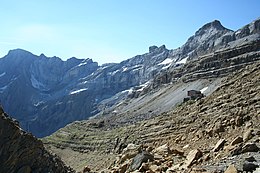| This article relies largely or entirely on a single source. Relevant discussion may be found on the talk page. Please help improve this article by introducing citations to additional sources. Find sources: "Tour du Marboré" – news · newspapers · books · scholar · JSTOR (February 2020) |
| Tour du Marboré | |
|---|---|
 View of the south face in summer View of the south face in summer | |
| Highest point | |
| Elevation | 3,009 m (9,872 ft) |
| Listing | List of Pyrenean three-thousanders |
| Coordinates | 42°41′08″N 0°01′02″E / 42.68556°N 0.01722°E / 42.68556; 0.01722 |
| Geography | |
 | |
| Location | France — Spain |
| Région Communauté | Midi-Pyrénées Aragon |
| Département Province | Hautes-Pyrénées Huesca |
| Parent range | Massif du Mont-Perdu (Pyrenees) |
Tour du Marboré or Tour de Gavarnie is a Pyrenean summit, culminating at 3,009 m (9,872 ft), located on the Franco-Spanish border crest in the Monte Perdido Range.

Toponymy
see: Cilindro de Marboré
Topography
The Tour du Marboré is part of the range above Cirque de Gavarnie. It marks the border between the Pyrenees National Park of France and the Ordesa y Monte Perdido National Park of Spain.
- On the French side, it is located in the commune of Gavarnie in the canton of Luz-Saint-Sauveur, Hautes-Pyrénées department, Midi-Pyrénées region.
- On the Spanish side, it is located in the comarca of Sobrarbe, Huesca province, Aragon.

Mountaineering
In 1956, it was climbed from the northern side by Jean Ravier and Claude Dufourmantelle.
References
- ^ Source : cartes IGN à l'échelle 1:25000 sur Géoportail